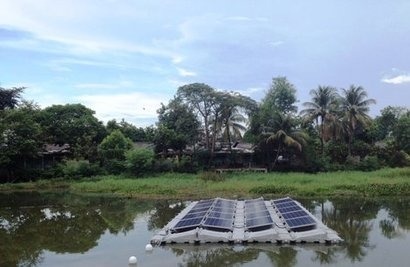
REC has one of the largest vertically integrated and fully automated production facilities in Southeast Asia. The company has partnered with local independent power producer (IPP) PT Kas Green Energy to introduce the floating solar installation through a pilot project at the Electricity & Renewable Energy Museum (Museum Listrik dan Energi Baru - MLEB), Taman Mini Indonesia Indah, in East Jakarta. This is the only Science and Technology museum in Indonesia with a collection of Electricity and Renewable Energy exhibits.
The 5 kilowatt peak floating PV installation at the MLEB is situated in a man-made lake and was completed on 6th May 2016. It features 20 REC Peak Energy Series panels and is expected to generate 6.7 MWh of energy per year, displacing 5.8 tons of CO2 per year. The demonstration display also helps to educate and generate environmental awareness at the museum.
Costs for solar have fallen by over 50 percent over the last six years with the advancement of new technology. Consequently, solar is expected to be the world’s most common energy source by 2050, with generation costs expected at US$0.02 to $0.04 per kilowatt hour. However, the growth potential for ground-mounted solar installations may be slightly dampened by the availability of land resource in some regions. For this reason, floating PV is a practical alternative.
Indonesia is a new and emerging market with untapped potential for further growth and adoption of solar. It is one of the largest and most heavily populated countries in Southeast Asia and has been experiencing stable grid connectivity challenges. In order to address dependency on fossil fuels, Indonesian policy-makers have encouraged the introduction of renewable energy into the country’s energy mix.
“We are delighted to support our high-performing solar panels for this pilot floating PV installation in Indonesia” said Torgeir Ulset, REC’s Vice President for Sales and Marketing in Asia-Pacific. “Stringent tests have confirmed REC’s Peak Energy solar panels to be suitable for deployment at floating solar installations. The high standards of reliability, performance and quality are consistent with the rooftop and ground-mounted installations. With a reliable power output and high quality standards, adopters of floating solar installations can be assured of the long-term performance of their REC solar panels. Therefore, REC extended its product and performance guarantee to floating applications.”
Kukuh Apriyanto, the President Director of PT Kas Green Energy, added that the inaugural floating PV installation is a public showcase of how valuable land can be conserved and unused water surface can become profitable solar power plants. Floating solar panels conserve precious land for farming, tourism and other land-intensive activities.
REC believes that with sizes ranging from a few kilowatts to several megawatts, floating solar installations can power thousands of households, and enable, otherwise underutilised artificial freshwater bodies to double up as real estate for floating solar installations. In general, various fresh water reservoirs are suitable – wastewater ponds at water treatment facilities and chemical plants, irrigation storage ponds at farms or vineyards, dam reservoirs and aquacultures, all largely available in most countries. Furthermore, with panels shading the water surface, there is less evaporation and photosynthesis in the water itself, which means less algae to clear from ponds.
No major excavation, concrete foundation or banks occupation of the lake are required. The solar panels are quickly installed on Hydrelio pontoons which are 100 percent recyclable and are easy to dismantle. Made of high-density polyethylene (HDPE), they can be installed safely on drinking water reservoirs and are resistant to UV light.
For additional information:

